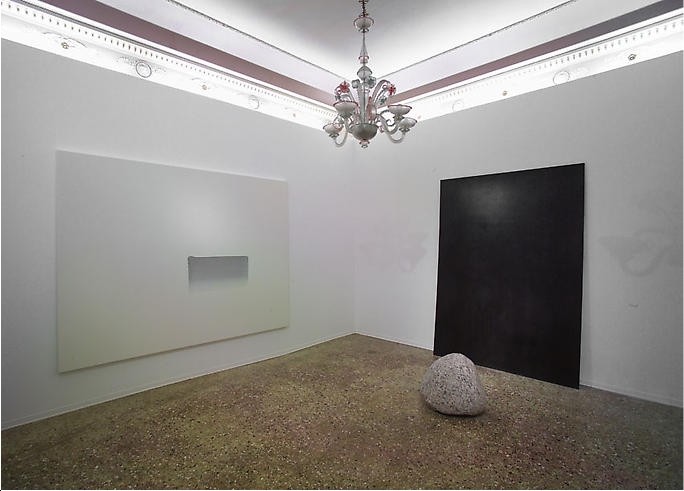Lee Ufan
02 Apr - 10 May 2008
LEE UFAN
Lisson Gallery is pleased to present new works by Lee Ufan in his latest solo exhibition in London. One of the most significant Asian artists of his generation, Lee's exploration of "the art of emptiness" results in works of beautiful and thought provoking simplicity. This exhibition will use the three gallery spaces in their entirety incorporating new paintings and works on paper and a selection of sculptures from the last twenty years.
Following his critically acclaimed solo exhibition at the 52nd Venice Biennale last year, Lee's new paintings continue his 'Correspondance' and 'Dialogue' series: minimal white canvases that are defined by one or sometimes two broad grey brushstrokes. Lee's methodology is reductive and based on an utter concentration on essential elements. Gesture and the body play a key role in the making of his paintings, during which Lee crouches on a wooden plank placed over the surface of the canvas. Each brushstroke is applied slowly and is composed of several layers of crushed stone mixed with pigment. Where the brush first makes contact with the canvas, the paint is thick, forming a 'ridge' that gradually becomes lighter. Rarely does his brush touch the surface more than three times. Lee has said "When I make a brush mark on the canvas, I hold my breath, I concentrate and I pray that my hand, the brush and the canvas will be in harmony."
Lee Ufan's sculptural work explores emptiness and the void. Consisting of untreated materials like stone and iron, the sculptural compositions are silent yet suggestive. They manipulate the space that they inhabit and so condition the viewer's perception of it. Like the paintings, Lee's sculptures share a similar treatment of space and use of colour. These works express his preoccupation with the relationship between the painted and the unpainted, the made and the unmade, the interior and the exterior.
Born in Korea in 1936, Lee Ufan divides his time between Kamakura, Japan and Paris, France. Artist, theorist, poet and teacher, he is one of the founders of the avant garde Mono-ha (Object School) group. Lee Ufan received the UNESCO Prize at the Shanghai Biennale in 2000; the Ho-Am Prize of the Samsung Foundation in Korea in 2001; and the 13th Praemium Imperiale for painting in 2001. Major exhibitions of Lee Ufan's recent painting and sculpture were held at the Yokohama Museum of Art in September 2005 and the Musée d'art Moderne Saint-Etienne in France in December 2005. The Kunst Situation, a museum associated with Bochum University in Germany, opened in November 2006 with a gallery devoted to a permanent installation of Lee Ufan's paintings and a garden of his sculpture.
On the occasion of this exhibition, Lisson Gallery will publish the third edition of Lee Ufan's collected writings The Art of Encounter (translated into English).
Lisson Gallery is pleased to present new works by Lee Ufan in his latest solo exhibition in London. One of the most significant Asian artists of his generation, Lee's exploration of "the art of emptiness" results in works of beautiful and thought provoking simplicity. This exhibition will use the three gallery spaces in their entirety incorporating new paintings and works on paper and a selection of sculptures from the last twenty years.
Following his critically acclaimed solo exhibition at the 52nd Venice Biennale last year, Lee's new paintings continue his 'Correspondance' and 'Dialogue' series: minimal white canvases that are defined by one or sometimes two broad grey brushstrokes. Lee's methodology is reductive and based on an utter concentration on essential elements. Gesture and the body play a key role in the making of his paintings, during which Lee crouches on a wooden plank placed over the surface of the canvas. Each brushstroke is applied slowly and is composed of several layers of crushed stone mixed with pigment. Where the brush first makes contact with the canvas, the paint is thick, forming a 'ridge' that gradually becomes lighter. Rarely does his brush touch the surface more than three times. Lee has said "When I make a brush mark on the canvas, I hold my breath, I concentrate and I pray that my hand, the brush and the canvas will be in harmony."
Lee Ufan's sculptural work explores emptiness and the void. Consisting of untreated materials like stone and iron, the sculptural compositions are silent yet suggestive. They manipulate the space that they inhabit and so condition the viewer's perception of it. Like the paintings, Lee's sculptures share a similar treatment of space and use of colour. These works express his preoccupation with the relationship between the painted and the unpainted, the made and the unmade, the interior and the exterior.
Born in Korea in 1936, Lee Ufan divides his time between Kamakura, Japan and Paris, France. Artist, theorist, poet and teacher, he is one of the founders of the avant garde Mono-ha (Object School) group. Lee Ufan received the UNESCO Prize at the Shanghai Biennale in 2000; the Ho-Am Prize of the Samsung Foundation in Korea in 2001; and the 13th Praemium Imperiale for painting in 2001. Major exhibitions of Lee Ufan's recent painting and sculpture were held at the Yokohama Museum of Art in September 2005 and the Musée d'art Moderne Saint-Etienne in France in December 2005. The Kunst Situation, a museum associated with Bochum University in Germany, opened in November 2006 with a gallery devoted to a permanent installation of Lee Ufan's paintings and a garden of his sculpture.
On the occasion of this exhibition, Lisson Gallery will publish the third edition of Lee Ufan's collected writings The Art of Encounter (translated into English).

